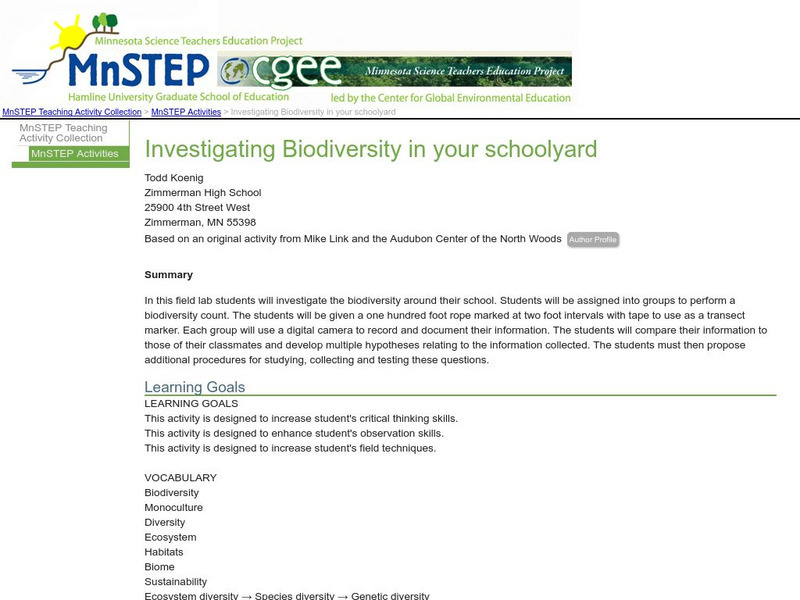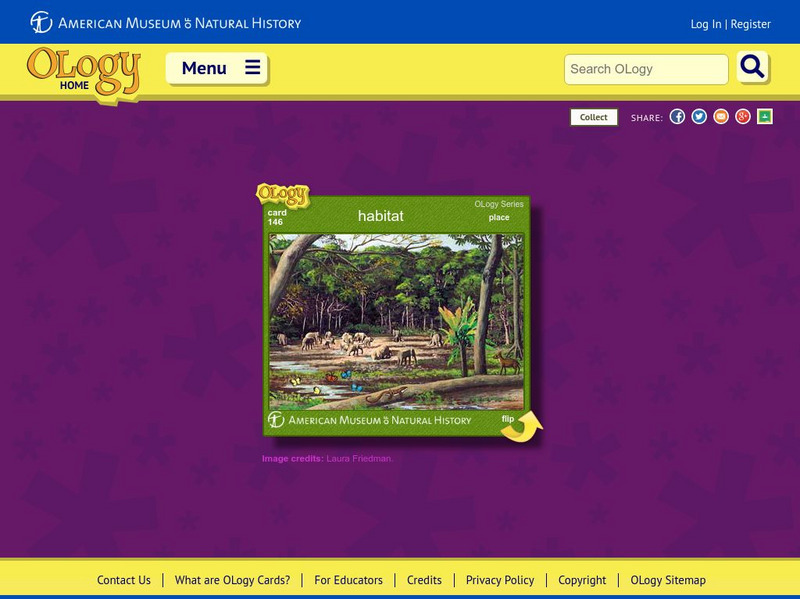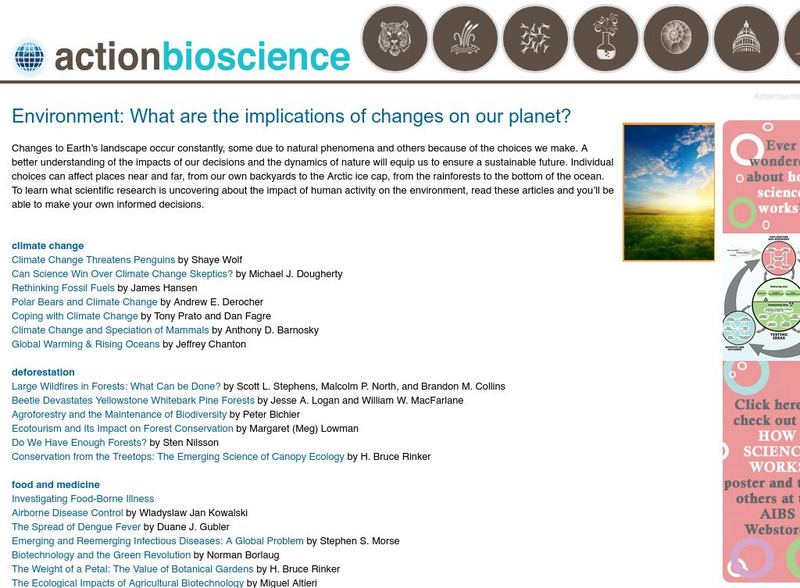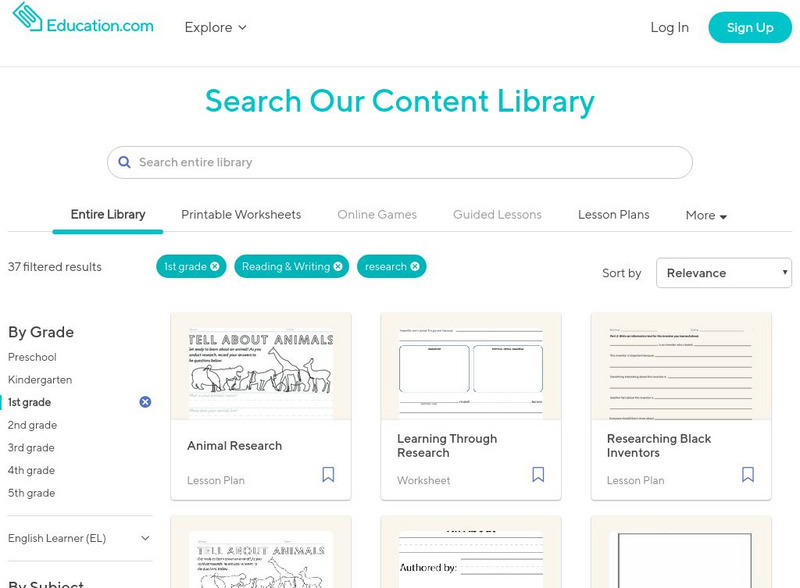Environmental Education for Kids
Eek!: Lake Superior
This site provides facts, illustrations, and more about the largest Great Lake. Includes descriptions of wildlife and industry. For grades 4-8.
Science Education Resource Center at Carleton College
Serc: Investigating Biodiversity in Your Schoolyard
For this field lab, young scholars will investigate the biodiversity around their school and record and document the information they find. The students will compare their information to those of their classmates, develop multiple...
Science Education Resource Center at Carleton College
Serc: Microbial Communities
This 1986 journal article reports that most microbial communities have escaped description. Article covers communities and ecosystems, microbial communities in termite intestines, microbial mats in evaporite flats, and microbial...
American Institute of Biological Sciences
Action Bioscience: Species, Speciation and the Environment
The American Institute of Biological Sciences offers this article by Niles Eldredge, evolutionary theorist and curator at the American Museum of Natural History. Eldredge begins with Darwin's theories and summarizes subsequent thought,...
PBS
Pbs Kids: Martha Speaks: Can You Dig It?
Practice reading with Martha with this illustrated, read-along story about the environment, habitats, and ecosystems.
PBS
Pbs Kids: Plum Landing: Outdoor Adventures
This collection of activities encourages kids to get outdoors and connect with nature. After completing the activities, kids draw, write, and answer questions about what they discovered and share that information with Plum.
PBS
Pbs Kids: Plum Landing: Jungle Jeopardy
Try keeping a whole jungle ecosystem alive by making sure each animal has enough food to survive over a period of 12 days. This game allows players to see how the different species of plants and animals in a rainforest depend on one...
PBS
Pbs Kids: Nature Sketchpad: Nature Sketchpad
This digital drawing activity lets students follow a variety of missions to create their own artwork.
PBS
Pbs Kids: Plum Landing: Can You Dig It?
Set in the Australian desert, players become bilbies to search at night for food while looking out for hungry predators like dingos, foxes, and swooping eagles.
PBS
Pbs Kids: Plum Landing: Invaders!
This bustling game is a race to help Plum eliminate introduced or invasive species before they crowd out the native populations.
PBS
Pbs Kids: Plum Landing: Map Animal Habitats
In this Plum Landing activity, students will write or draw descriptions of where animals live in their neighborhoods. Students can publish their descriptions online.
Other
Brooklyn Expedition: Structures
If you've ever wondered how animals use their homes or what we are made of, this is the place to look. This site from the Brooklyn Children's Museum explores the shared characteristics among animal skeletons and homes, architecture, art...
American Museum of Natural History
American Museum of Natural History: Habitat O Logy Card
Flip this interactive OLogy card to find fast facts, questions and answers, and other bite-size pieces of information about the meaning of habitat, as a scientific concept, and learn why habitat is so important to plants and animals.
Government of Canada
Government of Canada: Environment: Ecosystem Initiatives
This resource provides information on ecosystem initiatives and the programs in Canada that are working to preserve area ecosystems.
Other
Rainforest Alliance: Species Profiles
This resource has rain-forest species profiles for amphibians, birds, mammals, insects, and plants. Each profile explains the organism's anatomy, habitat, diet, and threats.
Missouri Botanical Garden
Missouri Botanical Garden: Biology of Plants: Plant Adaptations
Read about how plants adapt to survive in different biomes. Includes a song, game, photos, and lesson plans.
American Institute of Biological Sciences
Action Bioscience: Issues in Environment
This site from American Institute of Biological Sciences provides a collection of articles on current issues in environmental science and human impacts on the environment. Several articles available in Spanish.
World Wildlife Fund for Nature
World Wildlife Fund Russia
This resource provides bilingual news and facts about wildlife issues and projects across Russia. A small collection of beautiful images and video clips. Special section for kids with puzzles and nature-related games such as Rescue the...
Education.com
Education.com: 1st Grade Reading & Writing Resources
[Free Registration/Login Required] This collection of first grade reading and writing resources contains lesson plans and worksheets that can be used during the research process.
McGill University
Mc Gill University: Canadian Biodiversity: Ecozones: Mixedwood Plains
This Mixedwood Plains ecozone extends along the Quebec City- Windsor corridor and the densely-populated region of Southern Ontario. This brief, concise description includes a collection of images of the animals and birds native to the...
Other
Covington Independent Public Schools: A Worm Farm
Students will observe firsthand that worms change organic waste into soil. Directions and a cut/paste worksheet are included in this lesson.
Other
The Rspb: A to Z of a Wildlife Garden
Learn the steps to making a good wildlife garden that attracts all types of wildlife.
Alabama Learning Exchange
Alex: Habitats
What is a habitat? In this lesson, young scholars will identify that a habitat has four elements, food, water, shelter, and space. Students will identify their own habitat and create a brochure describing the habitat in terms of food,...
Alabama Learning Exchange
Alex: Pretty Cool Penguins
This lesson is part of an interdisciplinary primary life science unit addressing adaptation and habitats by focusing on penguins. This lesson is primarily technology based and should take place near the end of the unit, after young...






















